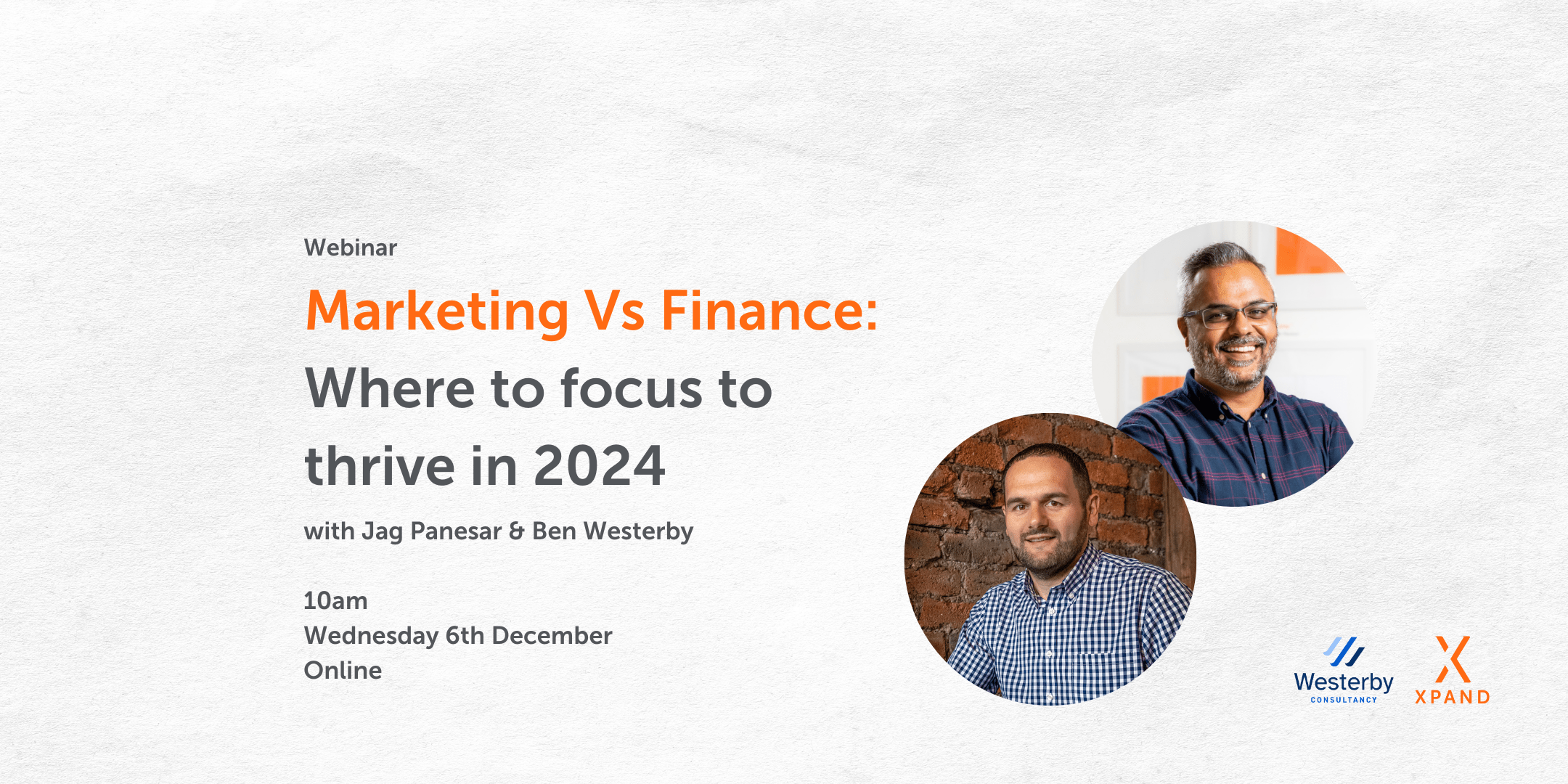Covid-19 has had a significant impact on the global economy, to say the least. This impact means that we, as business owners and marketers, need to action the right kind of measures to ensure we are able to survive and come out at the other end with a strong brand.
This webinar talks through 6 post lock down tactics that can help us achieve this.
Did you know?
- The UK economy slowed down by 20.4% in April due to lockdown
- There are 3 types of recession
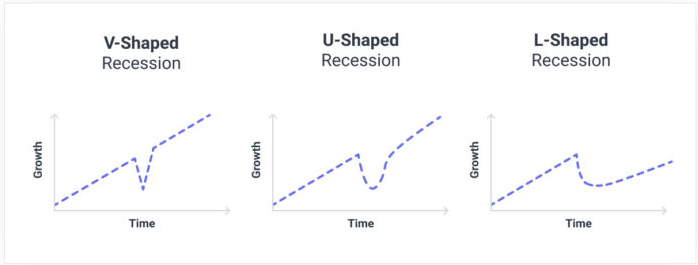
It is very likely the global economy will slip into a recession. There was already talk of this before Coronavirus impacted the world so it’s highly likely that a recession is just around the corner.
What we don’t know is what shape of recession, based on the above diagrams, that we will be in. In the best case scenario we want the V shape, a fast bounce back. I’m no economist, but the diagram says it all.
What’s your responsibility in this?
As a business owner or a marketer, by making the right moves and getting through the economic slowdown we can support:
- Softening the depth of the downturn
- Reducing the duration of the recession by accelerating your business in the upturn once the economy awakens
Tuesday 17th March 2020. I thought this might have been the end…
On the evening of Monday 16th March, Boris Johnson announced that those who can work from home should do so in order to reduce the risk of spreading Covid-19.
Fortunately we already had an emergency set up for snow days so were able to implement remote working immediately. I asked the team not to come into the office the next morning and for everyone to work from home.
The next day on Tuesday 17th March, I had to go in to collect a few important bits and pieces that myself or the team would have needed over, what we thought was going to be, the next couple of weeks (we were clearly very wrong!).
While in the office on my own that day, I was contacted by 3 clients that recognised the impact this will have on their businesses. They all called to cancel their contracts in order to cut costs. I understood and supported them however I could.
This was the first day of ‘semi-lockdown’. I thought to myself, if this is just the first day, what’s going to happen in the next week, two weeks, three weeks? I genuinely believed this could be the end of 13 years of blood, sweat and tears. Possibly a bit of an over reaction, but it was something I’d never experienced. It was something no one had ever experienced.
Fortunately, there weren’t many more clients that cancelled. It just so happened we were fortunate enough to get the go ahead on a number of projects a few weeks into lockdown which helped bring back the confidence we needed to push ahead.
I feel very lucky for this to have happened. Realistically though, it was due to the strength of our pipeline and planning from the previous 6 months so luck didn’t have a lot to do with it.
“I’m a great believer in luck, and I find the harder I work the more I have of it.”
Thomas Jefferson, American Founding FatherWe’re all in this together now. This webinar outlines 6 Post Lockdown Marketing Tactics that you can implement yourselves to survive the tough times ahead.
What you need post lockdown
You need a post lockdown marketing strategy. Most marketing strategies created pre-Coronavirus will likely be out dated. The landscape has changed significantly for some businesses, and mildly for others.
Either way it’s changed through unprecedented (the one and only time I will use that word!) circumstances so you need to re-assess how you’re going to reach your audience and build your brand.
A strategy has the following features:
- It provides long term objectives
- It assesses your competition and where you sit in relation to them – your competitive advantage
- It outlines the markets and audiences to target
- It outlines your brand position
- It provides a road map of what needs to happen and when
What are marketing tactics?
- The more granular activities that help you achieve your marketing strategy
- The day to day activity
- The things you plan in the very near future that contribute to building your brand
In this webinar, I will be talking about the things you can easily do without having to re-educate yourself or invest in external bodies such as marketing agencies. This of course can be done, but I’m hoping this session will equip you with ways you can make changes yourself.
I won’t be talking about deep technical things like SEO, PPC or social media advertising. These can be tactical but they need a good strategy behind them to be effective.
The things we talk about today can be joined together to make up parts of your marketing strategy.
The challenges you will face during recession
- People will become more price sensitive
- Purchases will become more considered
- Negotiation from prospects will be tougher
- Certain types of media will suffer significantly e.g. print media poses the risk of transferring the virus. I recently spoke to one of my contacts that runs a lifestyle magazine with a dependence on advertising for revenue streams. The risk of transferring the virus through numerous people picking up and reading magazines in a hair salon is significant so had to be stopped.
Tactic No.1: Penetrate your existing customer base
Think about what it costs you to win every new customer.
Think about your overall spend on all your marketing over the past 12 months and how many new customers you have acquired through each channel.
A very simple overview calculation would be to divide the money spent by the number of new clients you have acquired.
Now think about your existing clients, people you have worked with for the past few years. Have they made repeat purchases from you? Have they bought additional services from you?
It’s always more cost effective to sell to existing customers than to new customers.
Think about your customers’ needs
I carried out some research on LinkedIn and asked the question: After lockdown, what would you like to see most from your suppliers?
67% of the 51 respondents said they want an understanding of their needs.
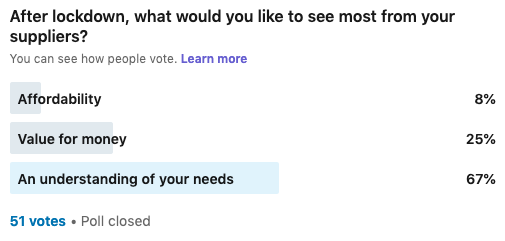
List all your valuable existing clients and take the time to talk to them. Understand what they need. Ask them directly, ‘what is most important to you in relation to what we offer?’.
See if you can find a consistent pattern and place emphasis around that.
Support the customers that are suffering
If you have customers that are suffering, try to help them out. One of our clients is a dental practice and had to shut down completely during lockdown. He asked if there was anything we could do to help so we temporarily reduced their monthly hosting fees.
This obviously has an impact on us, but it helped the client at a time of need – every penny counts!
You have to judge something like this on a case by case basis and obviously can’t cut your fees left, right and centre. In this case it is to help those most in need.
The client will no doubt appreciate this and remember us for helping them out at a time of need.
Extend credit terms
For this same client I extended their credit terms beyond the usual 30 days. This also helped support them in relieving elements of their immediate cashflow problem.
Again, only do this if it is feasible for you. You have to calculate the risk before you take it and have the trust in your clients to eventually pay.
Any finance people reading this will think I’m crazy for saying this because it goes against what they have been trained to do. From a marketing perspective, it helps the client and therefore wins long term loyalty. A short term pain for a long term gain.
Offer more value
In a perfect world, you want customers to buy on the value they see in your brand, not just price. Times are about to get very tough so try to go above and beyond in what is being offered. This can be done by:
- Providing more advice around your area of expertise
- Providing additional services at a lower rate
- Throwing in the occasional ‘freebie’. This will create customer delight, which goes a long way.
Tactic No.2: Emphasise your core values and how they fit around your approach to business during tough times
Think about SOLAR7. Your brand and message is at the heart of what you do. Core to your brand are your company values.
Your values are the fundamental beliefs upon which your business and its behaviour are based.
Your values should come across in the way that you and your team do things as a business. Your target audience should be able to recognise your values based on the things you say and do.
Here are our core values:
- Enjoy life and be friendly
- Push your creativity
- Challenge for positive results
This is how I have communicated these values internally in relation to the difficult times ahead.
- Enjoy life and be friendly
If you see that someone is struggling, think about what you can do to help them. Just a useful pointer in the right direction can sometimes be very valuable to them. Don’t take your own knowledge for granted. Do the right thing.
We had a client in the shop fitting sector that wanted to add a testimonials page to their website as part of their approach to winning new business. I could have easily given a price and done the work but instead I pointed them towards a route to market that would be more effective than just a testimonials page on their website.
I pointed them to a recording of one of our webinars about becoming a LinkedIn All Star which they were really grateful for.
They needed to get very proactive very quickly and I highlighted that reaching out to prospects via LinkedIn would be the most effective short term tactic.
The client was extremely grateful for the advice and he didn’t have to pay a penny for it. After implementing the advice, he came back and placed an order for additional work he needed.
2. Push your creativity
Innovation is key to many businesses during this period of time. Think about creative ways we can help people to achieve their goals. Their short-term goal may just be survival. A good idea from us could be the difference of people keeping their jobs or losing them.
3. Challenge for positive results
Times are currently very challenging. It’s challenge that takes us out of our comfort zones and that’s how we grow. Challenge yourself to see how you can grow. Challenge yourself to see how you can help a struggling client. Challenge yourself to see how you can get a better result for a client. Our clients need our support more now than ever before.
I regularly challenge my team to be more efficient in the way they work. In turn, they challenge me to provide improvements in our infrastructure to help them do what I am asking. Everyone is a winner in this situation.
Tactic No.3: Create value adding content to gain and retain clients
Content is at the heart of the SOLAR7 model and central to all the channels that deliver traffic to your website.
What you say will be difference between whether people engage with you or not.
The competitive landscape is about to get even more competitive so you need to stand out.
Buyers are likely to start spending more time in the consideration and engagement stages in the sales funnel because they need to be more careful with how they spend.
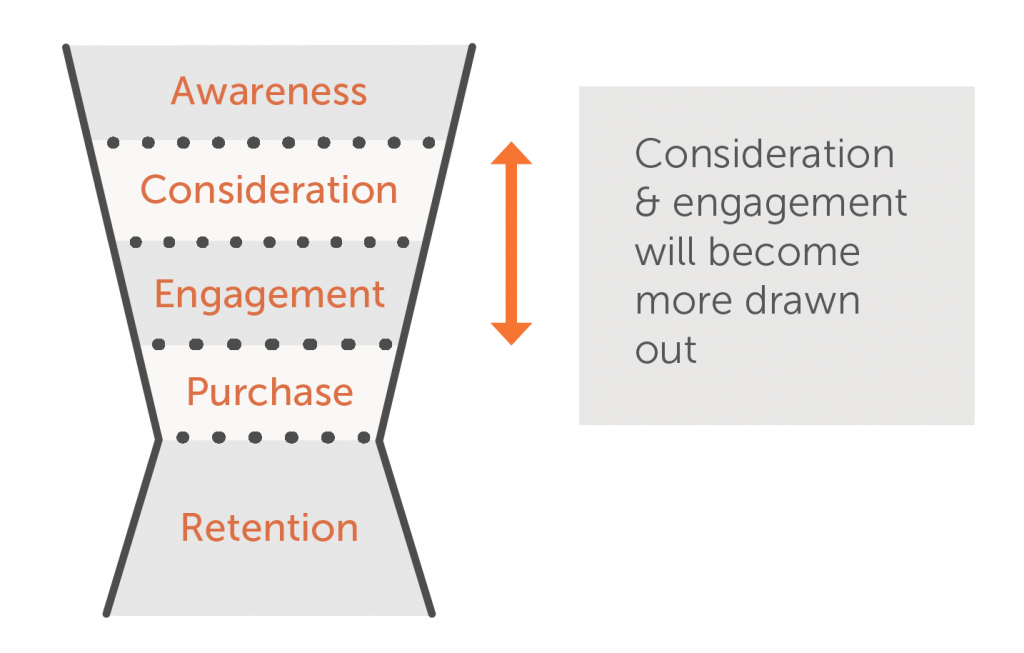
Types of content you can create
- ‘How to’ guides
- Opinion pieces around your area of expertise
- Thought leadership pieces
- An outline of the history of your specialism
- How your specialism can be used to survive the recession
Where you can place this content
- Your blog
- Social media – LinkedIn Pulse articles
- Webinars
- Podcasts
Think emotion
People buy on emotion.
Research from the University of Glasgow suggests that there are 4 core feelings:
- Happy
- Sad
- Afraid/ surprised
- Angry/ disgusted
Think about your target audience. Split them into various personas and then think about what pain points they have. Right now, the economic slump will be one of them.
Think about the message you can give associated with your service that they will associate with their pain point. Here are a few examples:
Examples
For an accountancy firm, rather than writing a blog titled ‘Ways to become more tax efficient’, title it ‘Ways to become tax efficient during troubled economic times’.
For a finance brokerage, rather than writing a blog titled ‘How to manage your cashflow better’, title it ‘5 cashflow mistakes you need to avoid’
For a marketing agency, rather than running a webinar titled ‘6 Marketing Tactics to Build Your Business’, title it ‘6 Post Lockdown Marketing Tactics’
Shape your content around your target audiences’ pain point.
Build trust through reviews
Content doesn’t always have to be created internally.
Ask your customers to leave reviews for you. Platforms could include:
- Google reviews
- LinkedIn recommendations
- Yell
- Trustpilot
Getting clients to leave reviews is always a challenge. When you ask, they’ll likely say yes but they obviously have other things to think about.
The most likely time you’ll be able to gain a review is when your client is delighted at something you’ve done. Think about tip no.1 – penetrating existing customers and giving extra value to create customer delight.
Up to date regular reviews will contribute to building your prospects confidence in you which will give that extra chance of them buying from you.
Tactic No.4: Productising your service to differentiate yourself
What is productising?
A productized service simplifies and focuses your business’ marketing operations into a model that is more predictable, process focused, and easier to sell.
What is the benefit of productisation?
- It helps differentiate you against your competition
- It demonstrates visual expertise
- It makes your service easier to understand – don’t take your knowledge for granted.
SOLAR7
Digital marketing can sometimes be seen as confusing to those that are not in the know. For years I would try to sketch out how it works in meetings but never really succeeded.
SOLAR7 is possibly a 6th iteration of previous failed attempts at visually depicting what we do and what the outcome is. These iterations happened over a number of years. I finally cracked it in 2017!
I roughly sketched out what was in my head and showed it to team. Our web developer at the time said it looked a bit like a solar system, and the name SOLAR7 was born.
The response to date has been very good and the model has been very well received.
It has laid the foundation for a lot of content that has been created over the years.
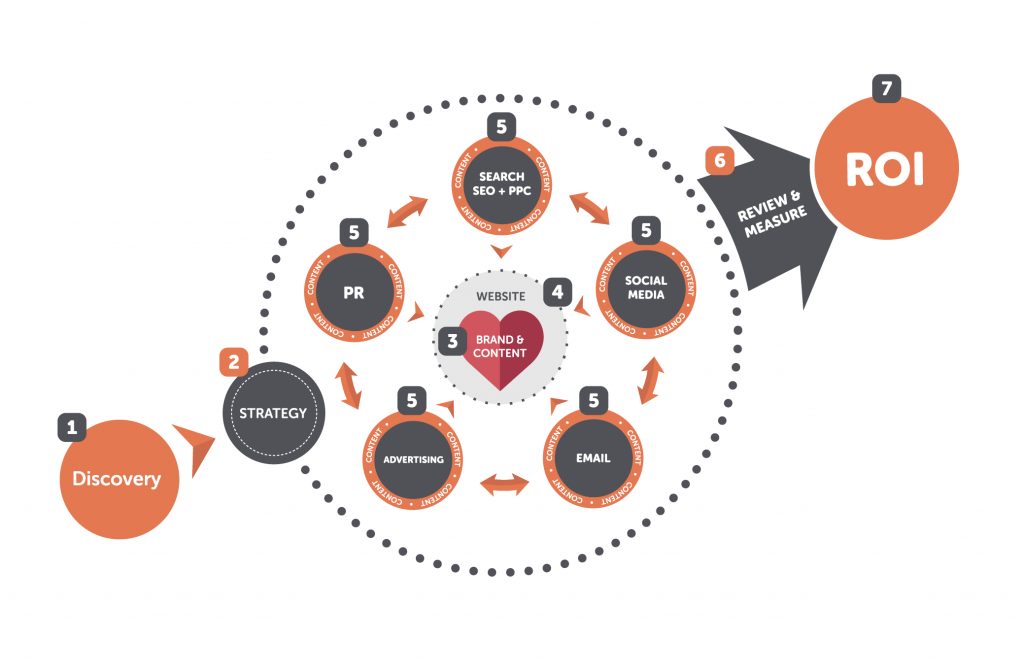
Things to consider
- The key to any model of this kind is to highlight the outcome from it.
- Name the model. Make it relate to something we recognise in the real world. This will make it more memorable.
- It may not happen over night. You may have to go through various iterations.
Creating packages
Another form of productisation is creating packages.
Let’s imagine you are an accountancy practice. You offer a variety of services that range from simple self assessments for sole traders/ contractors to full auditing and management accounts.
A lot of people I know (including me) are not particularly excited by anything to do with accounting.
If you sell accountancy services, rather than listing your services as follows:
- Sole trader accounts
- Limited company accounts
- Management accounts
Productising them could be as follows:
- Business starter package – For new start businesses or one person businesses
- Business growth package – For limited companies looking to grow
- Business acceleration package – For businesses wanting our dedicated support
Packages for struggling businesses
How about creating a package dedicated to businesses that may be struggling? Maybe something that is lower in price and provides the base benefits of your skillset?
You could argue that you are de-valuing yourself by dropping your price but if you are specific about what a business gets for this, you will likely be creating an opportunity to upsell to bigger packages further down the line when your customer is no longer struggling.
Tactic No.5: Understanding your competition in the digital landscape
How often do you scope out your competition? As in, sit down and assess what they are doing and actually have a written outline of this?
If it’s every now and then, make it more regular. I would recommend the following:
List at least 3 of your competitors
List at least 3 benchmark companies of a similar size to you that you don’t necessarily compete with
Go onto social media and search for them. Platforms to look on could be LinkedIn, Facebook, Instagram or Twitter.
For each one, assess the following:
- No. of followers/ likes
- No of posts per day
- Shares per post
- Comments/replies per post
- Hashtags per post
- Type of content they post. Is it:
Create a content schedule based on what you have learnt from your competition.
Tactic No.6: Reviewing and measuring your marketing activity
Stage 6 of SOLAR7 is Review & Measure.
‘You can’t manage what you can’t measure’
Peter DruckerI’m a huge advocate of tracking information and making use of it to improve things.
If you don’t have a system for tracking, you need to start immediately. Things to track include:
- No of enquiries
- No of proposals/ quotes written
- Total value of quotes/ proposals sent out
- No of sales
- Value of each sale
From the above you’ll be able to calculate your conversion rate.
Conversion can be tracked by dividing the full value of all converted business in any given time frame by the full value quoted in the same time frame, and multiplying it by 100. This will give you your conversion rate percentage.
Here’s an example:
You sent out 10 quotes in May that came to a total value of £25,500. Out of those quotes you converted £15,000 into business in that month. Here’s the calculation:
£15,000 divided by £25,500 x 100 = 58.8% conversion rate
You also need to track the source of enquiry. If you know where a prospect heard about you and collate this information, you can allocate more marketing budget accordingly.
Everything we have talked about in this webinar focuses around supporting your conversion rate because this is one of things that will become more challenging during a recession.
Google Analytics
Another great tool for measuring is Google Analytics.
This is code that you can add to your website to help you understand how people are using your website once they are on there.
By tracking and understanding how people are using your website, you can adjust accordingly to help increase the number of enquiries you gain from it.
Our last webinar talked about 5 Ways To Convert Your Website Visitors into Customers. You can learn more about this here.
If you would like to learn more about how you can market your business post lockdown, get in touch.

